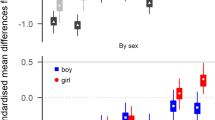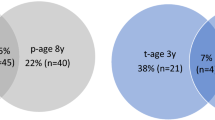The “Strengths and Difficulties” questionnaire was put to the parents and teachers of 342 schoolchildren aged 7–11 years using a non-randomized method. Questionnaire data from parents and teachers on children with ADHD and their peers were then compared. The spectrum of impairments arising in ADHD was found not to be restricted to the main symptoms of ADHD. Questionnaires completed by both parents and teachers showed that emotional impairments, behavioral problems, difficulties interacting with peers, and underdevelopment of social behavior were significantly more severe in children with ADHD as compared with healthy children. These results demonstrate the need for treatment to extend beyond addressing the basic symptoms to consider more general measures of patients’ quality of life.
Similar content being viewed by others
References
N. N. Zavadenko and N. Yu. Suvorinova, “Comorbid disorders in attention deficit hyperactivity disorder in children,” Zh. Nevrol. Psikhiat., 107, No. 7, 39–44 (2007).
International Classification of Diseases X Edition. Classification of Mental and Behavioral Disorders. Research Diagnostic Criteria [Russian translation], St. Petersburg (1994).
A. A. Novik and T. I. Ionova, Studies of the Quality of Life in Pediatrics [in Russian], Yu. L. Shevchenko (ed.), Russian Academy of Natural Sciences, Moscow (2008).
Developing Common Instruments for Health [Russian translation], A. Nosikov and C. Gudex (eds.), World Health Organization 2003 [Russian translation published by Prava Cheloveka, Moscow (2005)].
Diagnostic and Statistical Manual of Mental Diseases, 4th edition, (DSM-IV-TR), American Psychiatric Association, Washington DC (2000).
R. Goodman, “The extended version of the Strengths and Difficulties Questionnaire as a guide to child psychiatric caseness and consequent burden,” J. Chil Psychol. Psychiat., 40, 791–801 (1999).
R. Goodman, “Psychometric properties of the Strengths and Difficulties Questionnaire (SDQ),” J. Am. Acad. Child Adolesc. Psychiat., 40, 1337–1345 (2001).
R. W. Greene, J. Biederman, S. V. Faraone, et al., “Adolescent outcome of boys with attention-deficit/hyperactivity disorder and social disability: results from a 4-year longitudinal follow-up study,” J. Consult. Clin. Psychol., 65, 758–767 (1997).
C. Johnson and E. J. Mash, “Families of children with ADHD: review and recommendations for future research,” Clin. Child Fam. Psychol. Rev., 4, 183–207 (2001).
L. S. Matza, A. M. Rentz, K. Secnik, et al., “The link between health related quality of life and clinical symptoms among children with attention-deficit hyperactivity disorder,” J. Dev. Behav. Pediat., 25, 166–174 (2004).
National Institute for Health and Clinical Excellence, “Methylphenidate, atomoxetine and dexamfetamine for attention deficit hyperactivity disorder (ADHD) in children and adolescents,” Review of Technology Appraisal 13. Technol. Appraisal (2006).
A. R. Perwien, Ch. J. Kratochvil, D. E. Faries, et al., “Atomoxetine treatment in children and adolescents with Attention-Deficit Hyperactivity Disorder: what are the long-term health-related quality-of-life outcomes?” J. Child Adol. Psychopharmacol., 16, 713–724 (2006).
S. Prasad, V. Harpin, L. Poole, et al., “A multi-centre, randomised, open-label study of atomoxetine compared with standard current therapy in UK children and adolescents with attention deficit/hyperactivity disorder (ADHD),” Curr. Med. Res. Opin., 23, 379–394 (2007).
M. G. Sawyer, L. Whaites, J. M. Rey, et al., “Health-related quality of life of children and adolescents with mental disorders,” J. Am. Acad. Child Adol. Psychiat., 41, 530–537 (2002).
T. W. Strine, C. A. Lesesne, C. A. Okoro, et al., “Emotional and behavioral difficulties and impairments in everyday functioning among children with a history of attention-deficit/hyperactivity disorder,” Preventing Chronic Disease. Publ. Health. Res. Pract. Policy, 3, 1–10 (2006).
Author information
Authors and Affiliations
Corresponding author
Additional information
Translated from Zhurnal Nevrologii i Psikhiatrii imeni S. S. Korsakova, Vol. 109, No. 11, pp. 53–57, November, 2009.
Rights and permissions
About this article
Cite this article
Zavadenko, N.N., Lebedeva, T.V., Schasnaya, O.V. et al. Attention Deficit Hyperactivity Syndrome: The Role of Parent and Teacher Questionnaires in Assessing the Social and Psychological Adaptation of Patients. Neurosci Behav Physi 41, 52–56 (2011). https://doi.org/10.1007/s11055-010-9378-1
Published:
Issue Date:
DOI: https://doi.org/10.1007/s11055-010-9378-1




